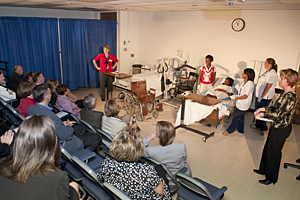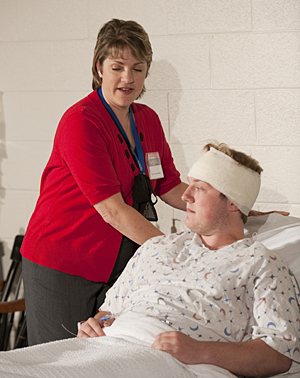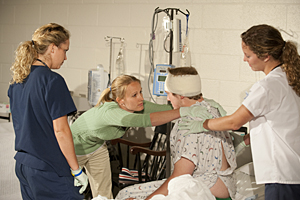

ADVERTISEMENT
- Rozovsky wins prestigious NSF Early Career Award
- UD students meet alumni, experience 'closing bell' at NYSE
- Newark Police seek assistance in identifying suspects in robbery
- Rivlin says bipartisan budget action, stronger budget rules key to reversing debt
- Stink bugs shouldn't pose problem until late summer
- Gao to honor Placido Domingo in Washington performance
- Adopt-A-Highway project keeps Lewes road clean
- WVUD's Radiothon fundraiser runs April 1-10
- W.D. Snodgrass Symposium to honor Pulitzer winner
- New guide helps cancer patients manage symptoms
- UD in the News, March 25, 2011
- For the Record, March 25, 2011
- Public opinion expert discusses world views of U.S. in Global Agenda series
- Congressional delegation, dean laud Center for Community Research and Service program
- Center for Political Communication sets symposium on politics, entertainment
- Students work to raise funds, awareness of domestic violence
- Equestrian team wins regional championship in Western riding
- Markell, Harker stress importance of agriculture to Delaware's economy
- Carol A. Ammon MBA Case Competition winners announced
- Prof presents blood-clotting studies at Gordon Research Conference
- Sexual Assault Awareness Month events, programs announced
- Stay connected with Sea Grant, CEOE e-newsletter
- A message to UD regarding the tragedy in Japan
- More News >>
- March 31-May 14: REP stages Neil Simon's 'The Good Doctor'
- April 2: Newark plans annual 'wine and dine'
- April 5: Expert perspective on U.S. health care
- April 5: Comedian Ace Guillen to visit Scrounge
- April 6, May 4: School of Nursing sponsors research lecture series
- April 6-May 4: Confucius Institute presents Chinese Film Series on Wednesdays
- April 6: IPCC's Pachauri to discuss sustainable development in DENIN Dialogue Series
- April 7: 'WVUDstock' radiothon concert announced
- April 8: English Language Institute presents 'Arts in Translation'
- April 9: Green and Healthy Living Expo planned at The Bob
- April 9: Center for Political Communication to host Onion editor
- April 10: Alumni Easter Egg-stravaganza planned
- April 11: CDS session to focus on visual assistive technologies
- April 12: T.J. Stiles to speak at UDLA annual dinner
- April 15, 16: Annual UD push lawnmower tune-up scheduled
- April 15, 16: Master Players series presents iMusic 4, China Magpie
- April 15, 16: Delaware Symphony, UD chorus to perform Mahler work
- April 18: Former NFL Coach Bill Cowher featured in UD Speaks
- April 21-24: Sesame Street Live brings Elmo and friends to The Bob
- April 30: Save the date for Ag Day 2011 at UD
- April 30: Symposium to consider 'Frontiers at the Chemistry-Biology Interface'
- April 30-May 1: Relay for Life set at Delaware Field House
- May 4: Delaware Membrane Protein Symposium announced
- May 5: Northwestern University's Leon Keer to deliver Kerr lecture
- May 7: Women's volleyball team to host second annual Spring Fling
- Through May 3: SPPA announces speakers for 10th annual lecture series
- Through May 4: Global Agenda sees U.S. through others' eyes; World Bank president to speak
- Through May 4: 'Research on Race, Ethnicity, Culture' topic of series
- Through May 9: Black American Studies announces lecture series
- Through May 11: 'Challenges in Jewish Culture' lecture series announced
- Through May 11: Area Studies research featured in speaker series
- Through June 5: 'Andy Warhol: Behind the Camera' on view in Old College Gallery
- Through July 15: 'Bodyscapes' on view at Mechanical Hall Gallery
- More What's Happening >>
- UD calendar >>
- Middle States evaluation team on campus April 5
- Phipps named HR Liaison of the Quarter
- Senior wins iPad for participating in assessment study
- April 19: Procurement Services schedules information sessions
- UD Bookstore announces spring break hours
- HealthyU Wellness Program encourages employees to 'Step into Spring'
- April 8-29: Faculty roundtable series considers student engagement
- GRE is changing; learn more at April 15 info session
- April 30: UD Evening with Blue Rocks set for employees
- Morris Library to be open 24/7 during final exams
- More Campus FYI >>
2:05 p.m., April 28, 2010----Candice was a college soccer star until a spinal cord injury sustained in a car crash left her paralyzed from the waist down. She lies in her hospital bed, rolling her eyes in disgust at the upbeat manner of the physical therapist and two nurses who come into her room to get her up for the first time since the accident.
Zack, also the victim of an auto accident, displays the erratic behavior of a head-injury patient. He picks frantically at the tape holding the IV in place on his hand, lashes out in unprovoked anger at the medical staff, and sags to the floor when they finally pull him to a standing position. His affect swings wildly from impassive silence to barely contained fury.
Fifteen minutes into their sessions with the hospital staff, the two patients get up and walk across the hospital room unassisted.
Candice Pryce and Zachary Jackson are actually theatre students, and their performance is part of a novel approach to educating future healthcare professionals at the University of Delaware. Their nurses and physical therapists are also students, who are presented with a realism that they would not encounter in practicing on mannequins or each other.
On Friday, April 16, a small group of faculty, staff, and alumni had the opportunity to see these two live simulations, when a classroom in UD's McDowell Hall was temporarily turned into a small theatre, complete with raised seating, curtained walls, and a spotlighted stage.
“We believe this is the only program of its kind in the U.S.,” said Allan Carlsen, undergraduate adviser and coordinator in UD's Department of Theatre, “and you're the first audience to see this production.”
Kathy Matt, dean of the UD College of Health Sciences, thinks that others could benefit from seeing it as well. “Not only is this another layer in our approach to preparing our students for the reality of patient care,” she says, “but it could also be very educational for the public, enabling people to see what it's like for the medical professionals who evaluate and treat them.”
According to Tara Jo Manal, director of clinical services in UD's Department of Physical Therapy, the program is based on the concept of the standardized patient, an individual trained to consistently simulate a specific medical condition or disease.
“Dr. Paula Stillman, an early proponent of this concept, is affiliated with Christiana Care, one of our partners in the Delaware Health Sciences Alliance, and we hope to use her as a resource as we expand the program,” Manal said before the production. “The approach enables our students to learn how to manage the unexpected without compromising the standard of care that we have to maintain when we're treating actual patients.”
The collaborative program at UD focuses on teaching future medical professionals how to deal with not only the physical symptoms but also the emotional responses of their patients.
“When people are in the hospital, they're stressed and that's what we want to simulate,” said Amy Cowperthwait, laboratory coordinator in UD's School of Nursing, during a debriefing following the simulations.
“Candice is angry, so she's not receptive to getting out of bed or to hearing about what she can do now that she can no longer play soccer. Actors are able to accurately portray the stages of grief, including, for example, anger and denial. One of the things that makes our program unique is that it incorporates the psychosocial aspects of injury and illness.”
The program also provides the acting students with valuable experience in accurately portraying the behavior associated with various diseases and disabilities. In addition, it prepares them to handle unscripted scenarios.
“It's like going out on the stage for opening night with three people who don't know the play,” said Jackson, the actor who played the brain-injured patient. “It gives us a chance to exercise our skills in an uncontrolled environment.”
Matt hopes to see additional disciplines -- for example, medical technology -- integrated into the program in the future. “This project is a great example of the interprofessional education and research opportunities that we envision with the build-out of the Chrysler site,” she said. “These efforts will include not only UD but also our partners in the DSHA.”
Article by Diane Kukich
Photos by Evan Krape



